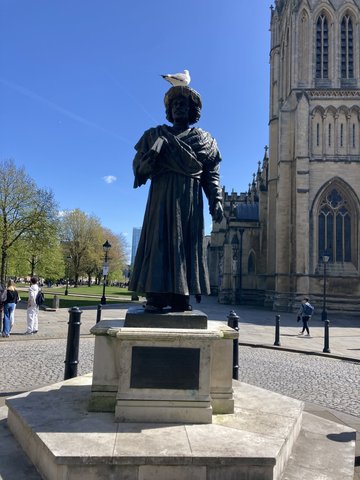
Rammohun Roy
‐
Brahmo Samaj reformer who visited Britain in the 1830s and died in Bristol in 1833
Other names
Rajah Rammohun Roy
Ram Mohan Roy
Place of birth
Date of arrival to Britain
Location(s)
United Kingdom
Place of death
Bristol
Date of time spent in Britain
1831–3
About
Rammohun Roy was a prominent Bengali social and religious reformer. He was one of the founders of the Brahmo Samaj, a Unitarian sect that began in 1828. He was a keen proponent of women’s rights and was known for his efforts to abolish the practice of sati (widow burning) and his opposition to child marriage.
In 1831 Roy visited Britain with his son, his namesake Ram Mohun Roy, and two Indian servants, Ramhurry Doss and Ramrotun Mukerjah. He visited Liverpool first, as a guest of William Rathbone, before moving to London, where his son was put under the tutelage and care of Rev. D. Davison. Roy struck up a keen friendship with the Unitarian minister Dr Lant Carpenter of Bristol (the father of Mary Carpenter) and in July 1833 sent his son to stay in Bristol ahead of his own visit. The younger Roy stayed at the house of Miss Kiddell and Miss Castle in Stapleton Grove. Miss Castle was the niece of Miss Kiddell and ward of Dr Carpenter. The senior Roy arrived in Bristol in September 1833 with his two servants and stayed at Stapleton Grove too.
On 19 September 1833 Roy fell ill and died on 27 September at Stapleton Grove. His head had become inflamed and it is likely that he had contracted meningitis. He was interred in the gardens of Stapleton Grove on 18 October 1833 following a simple ceremony. Harriet Martineau, the sociologist and Unitarian, wrote a hymn in remembrance of Roy that was later sung at a remembrance service in Finsbury in London.
In 1843 Dwarkanath Tagore, a Brahmo Samajist, travelled to Britain and arranged for the case containing his coffin to be removed from Stapleton Grove (which was no longer in the Castle family) to Arnos Vale Cemetery in Bristol. This was done on 29 May 1843 and a mausoleum was built around Roy’s tomb. A painting of Rammohun Roy, which was commissioned by Miss Castle and painted by H. Briggs in 1832, was presented to the Bristol Institution in 1841 by Miss Kiddell. It hangs in Bristol Museum. A statue of Roy made by Niranjan Pradhan in 1995 can be found on Bristol’s College Green, in front of the Central Library, and a bust of Roy, made on the day of his death, sits inside Bristol’s City Hall. Roy is remembered by the city in which he died for his Unitarian connections there. His tomb is a site of commemoration for Brahmo Samajists to this day, who perform an annual ceremony of remembrance every year on the anniversary of his death.
Carpenter, Mary, The Last Days in England of the Rajah Rammohun Roy (London: E. T. Whitfield, 1875)
Kopf, David, The Brahmo Samaj and the Shaping of the Modern Indian Mind (Princeton, NJ: Princeton University Press, 1979)
Midgley, Clare, ‘Cosmotopia Delineated: Rammohun Roy, William Adam, and the Calcutta Unitarian Committee’, Itinerario 44.2 (2020), pp. 446–70
Zastoupil, Lynn, Rammohun Roy and the Making of Victorian Britain (New York: Palgrave Macmillan, 2010)
Arnos Vale Cemetery Trust, Bristol Archives, Bristol
Information Box, Bristol Archives, Bristol
Lewins Mead Unitarian Meeting Papers, Bristol Archives, Bristol
Records of Mary Carpenter and the Red Lodge Reformatory, Bristol Archives, Bristol
Image credit
Photo taken for 'South Asian Britain' (2024)
